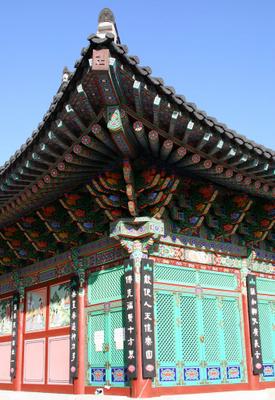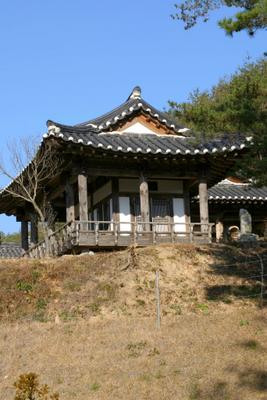A few details.
 This is a shot of a temple not far from Andong. I can't remember the name right now, but I could look it up if you want. This particular temple complex looks as if it was made specifically for instruction. There are several extra buildings that look as if they may be lecture halls or apartments for visitors. Those buildings aren't so interesting.
This is a shot of a temple not far from Andong. I can't remember the name right now, but I could look it up if you want. This particular temple complex looks as if it was made specifically for instruction. There are several extra buildings that look as if they may be lecture halls or apartments for visitors. Those buildings aren't so interesting.
 Korean temples are very ornately painted. The color palette isn't very large, but the details are very intricate. This can be very interesting the first time you see it. Even the second, third, and fourth times are nice. But if you spend enough time here, you soon realize that the saying, "If you've seen one (insert item here), you've seen them all" too often proves true for Korean temples. This is not to take away from the beauty. It is just that after a few temples you come to realize the sameness of most of them.
Korean temples are very ornately painted. The color palette isn't very large, but the details are very intricate. This can be very interesting the first time you see it. Even the second, third, and fourth times are nice. But if you spend enough time here, you soon realize that the saying, "If you've seen one (insert item here), you've seen them all" too often proves true for Korean temples. This is not to take away from the beauty. It is just that after a few temples you come to realize the sameness of most of them.
 Something that does make the temples different are the story panels around the buildings. If you look back at the first photo you can see a couple of these panels. Here is a close up. These panels usually tell the story of Buddha or some related incidents of his life or disciples. This panel depicts the Buddha's mother dreaming of a white elephant. This signified to her that she would give birth to a boy who would be come the Buddha. (It is a bit more complex than that, but that is the general idea.) What is interesting is how the story is interpreted on the panels between different temples and even different cultures.
Something that does make the temples different are the story panels around the buildings. If you look back at the first photo you can see a couple of these panels. Here is a close up. These panels usually tell the story of Buddha or some related incidents of his life or disciples. This panel depicts the Buddha's mother dreaming of a white elephant. This signified to her that she would give birth to a boy who would be come the Buddha. (It is a bit more complex than that, but that is the general idea.) What is interesting is how the story is interpreted on the panels between different temples and even different cultures.
 Here is a pagoda in the center of the temple complex. This is a rather modern version of the traditional pagoda theme.
Here is a pagoda in the center of the temple complex. This is a rather modern version of the traditional pagoda theme.
 A close up of one of the four Buddhas, one on each face. I used to be able to recognize which Buddha was which. They are all the same person, but the different poses represent a different aspect. I am not sure, but this one could be be the preaching/turning the wheel of law Buddha. Of course it would be a Korean interpretation of whichever image it is.
A close up of one of the four Buddhas, one on each face. I used to be able to recognize which Buddha was which. They are all the same person, but the different poses represent a different aspect. I am not sure, but this one could be be the preaching/turning the wheel of law Buddha. Of course it would be a Korean interpretation of whichever image it is.
Switching themes a bit ...
 I went to visit Seoul during the winter. And while there I visited a friend. She may not like this picture much, but I think she looks pretty.
I went to visit Seoul during the winter. And while there I visited a friend. She may not like this picture much, but I think she looks pretty.
 One of the bonuses of traveling around with someone is that they can sometimes take pictures of you. So here you have a rare picture of me. I am standing next to an ice rink the city of Seoul laid down on the plaza in front of city hall. I think the skating was free, but the line was horrendously long, so we didn't bother to give it a go.
One of the bonuses of traveling around with someone is that they can sometimes take pictures of you. So here you have a rare picture of me. I am standing next to an ice rink the city of Seoul laid down on the plaza in front of city hall. I think the skating was free, but the line was horrendously long, so we didn't bother to give it a go.
 Here is a wider shot of me in front of the Seoul city hall building. Built in 1926 during the Japanese occupation it is reminiscent of that utilitarian, no frills style of building often done by totalitarian governments.
Here is a wider shot of me in front of the Seoul city hall building. Built in 1926 during the Japanese occupation it is reminiscent of that utilitarian, no frills style of building often done by totalitarian governments.
Switching again ...
 I think I have mentioned before the historical set used for a TV drama which is near the culture museum. There is another part of the set built on the lake. Obviously this set was used for water and port scenes. I suppose these boats are historically accurate, but I am sure some license was taken with history to make things look better for TV.
I think I have mentioned before the historical set used for a TV drama which is near the culture museum. There is another part of the set built on the lake. Obviously this set was used for water and port scenes. I suppose these boats are historically accurate, but I am sure some license was taken with history to make things look better for TV.
 Here is a shot of the Naktong river just below the dam. The first bridge you see there is a car bridge and the second is a pedestrian bridge. The last structure you can see there, if you can see it, is actually a small dam just to control downstream flow. That is why the river is so broad right below the main dam.
Here is a shot of the Naktong river just below the dam. The first bridge you see there is a car bridge and the second is a pedestrian bridge. The last structure you can see there, if you can see it, is actually a small dam just to control downstream flow. That is why the river is so broad right below the main dam.
 Quick, without looking at the following picture, what do you think this is?
Quick, without looking at the following picture, what do you think this is?
 It is the face of Andong dam. It is basically an earthen dam, but it is covered by stones to protect it.
It is the face of Andong dam. It is basically an earthen dam, but it is covered by stones to protect it.
 If you couldn't tell if it was winter by the coats and the stark landscape, here is more proof. This is just a small frozen waterfall along the side of a road.
If you couldn't tell if it was winter by the coats and the stark landscape, here is more proof. This is just a small frozen waterfall along the side of a road. Back near the Naktong river is Sinse-dong Chilcheung jeontap (신세동 칠층전탑). It is a seven story brick pagoda. This one was a bit different than most in that each tier was covered over with roof tiles at one time, which is probably while there are still seven stories standing. You can see some of the roof tiles in the photo. It was built in the Shilla era (57 B.C.-A.D. 935), and stands about 17 meters tall. The perspective differences with the man and the car make it look a bit larger.
Back near the Naktong river is Sinse-dong Chilcheung jeontap (신세동 칠층전탑). It is a seven story brick pagoda. This one was a bit different than most in that each tier was covered over with roof tiles at one time, which is probably while there are still seven stories standing. You can see some of the roof tiles in the photo. It was built in the Shilla era (57 B.C.-A.D. 935), and stands about 17 meters tall. The perspective differences with the man and the car make it look a bit larger.  Here is an "art" shot of the pagoda.
Here is an "art" shot of the pagoda.
 And yet another taken from the back into the sun.
And yet another taken from the back into the sun. Just a couple of old style buildings, still in use, near the pagoda.
Just a couple of old style buildings, still in use, near the pagoda. . . .
. . .  This is another small froze water fall just up the hill from the last building.
This is another small froze water fall just up the hill from the last building.
 A close up of the ice.
A close up of the ice.
And finally, a shot of part of Andong from the hills that overlook the city. That is the Naktong river continuing on it's way. Remember to click any photo you might want to see it in a larger size. And please leave a comment if you feel like it.


















































